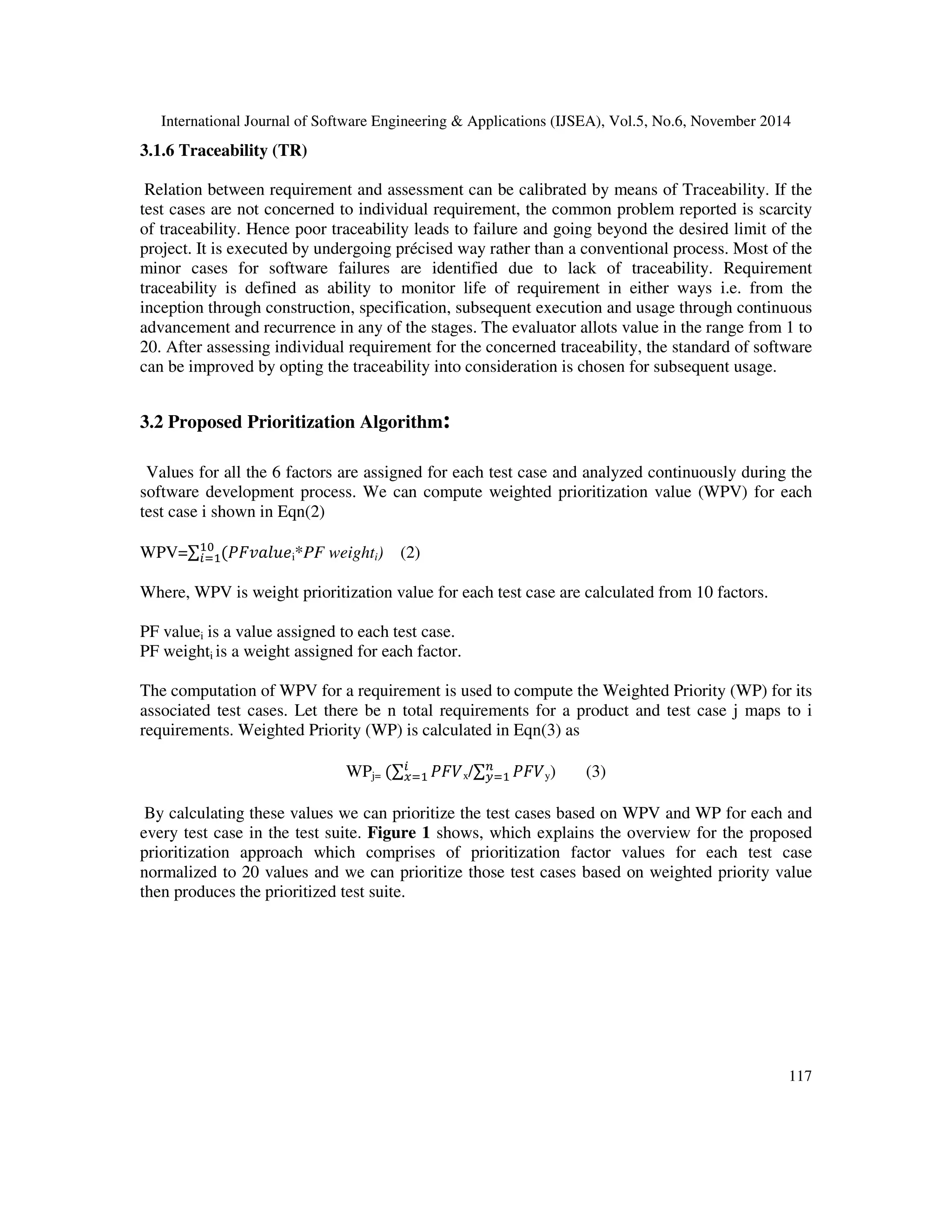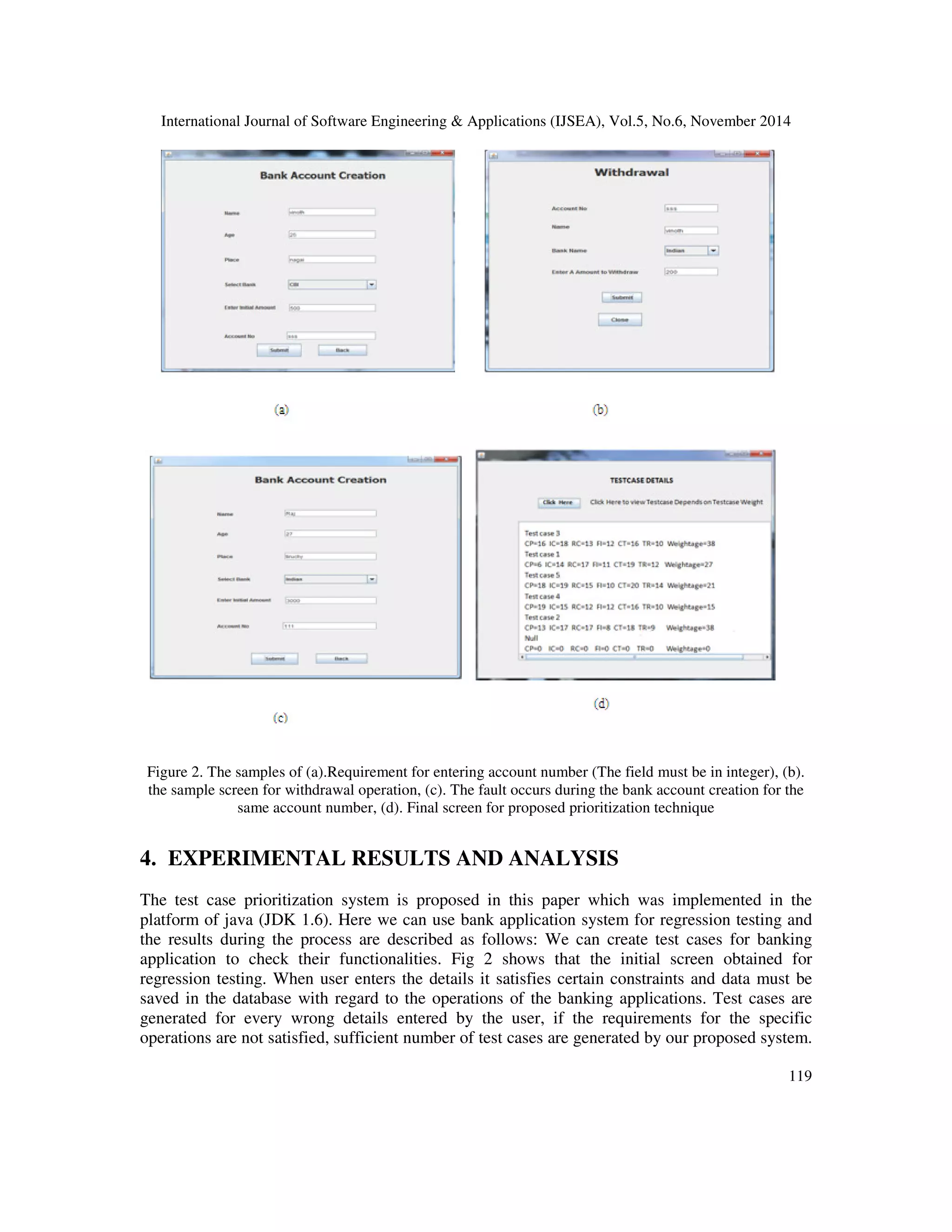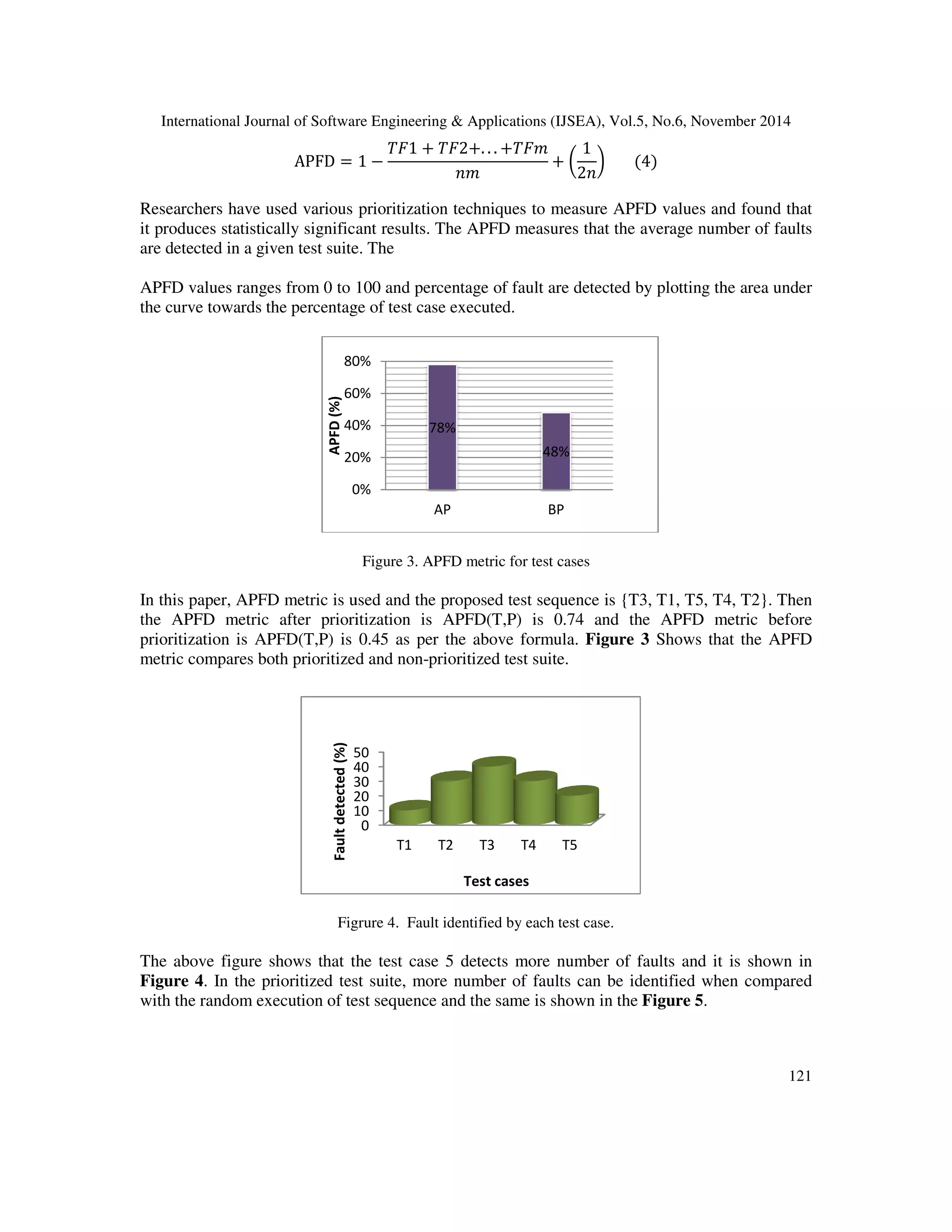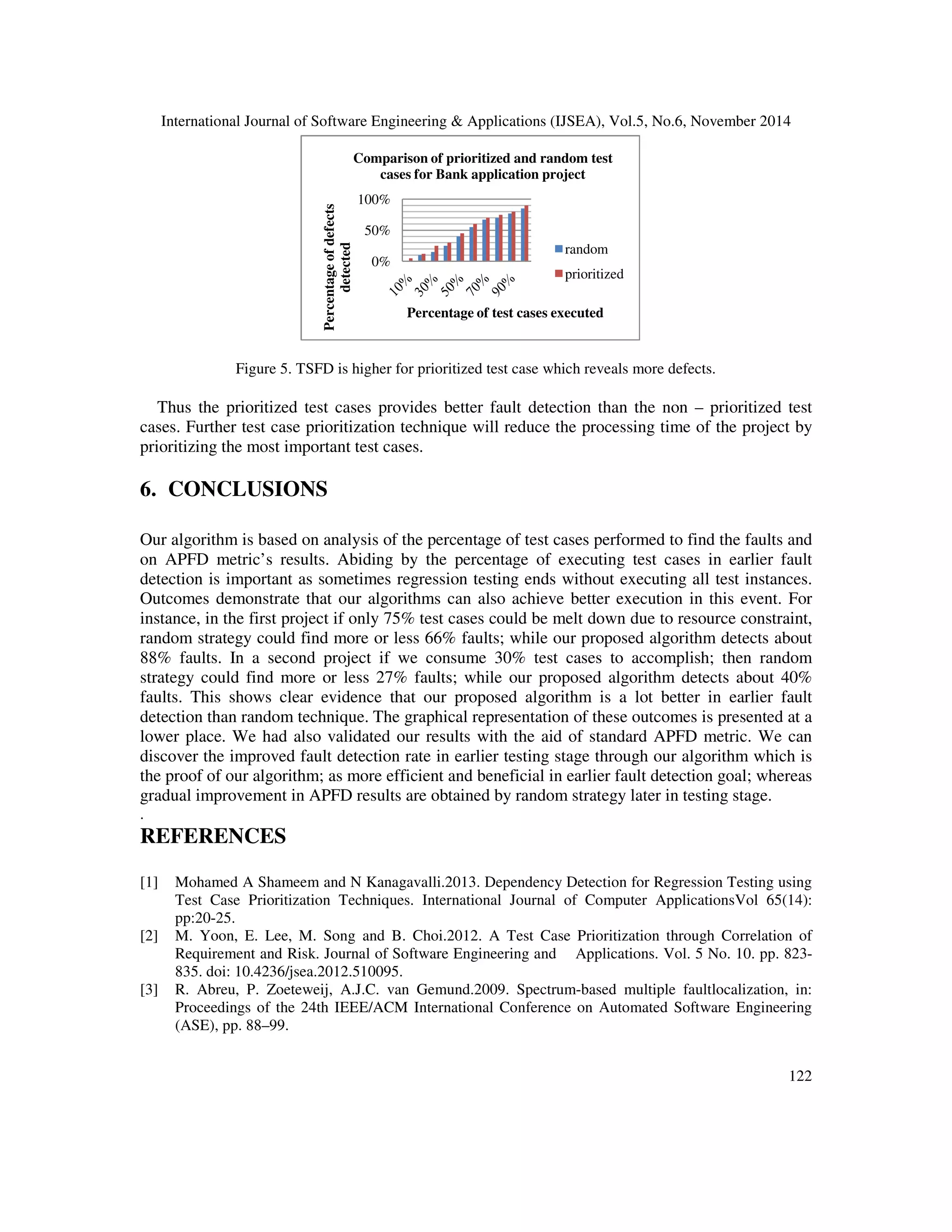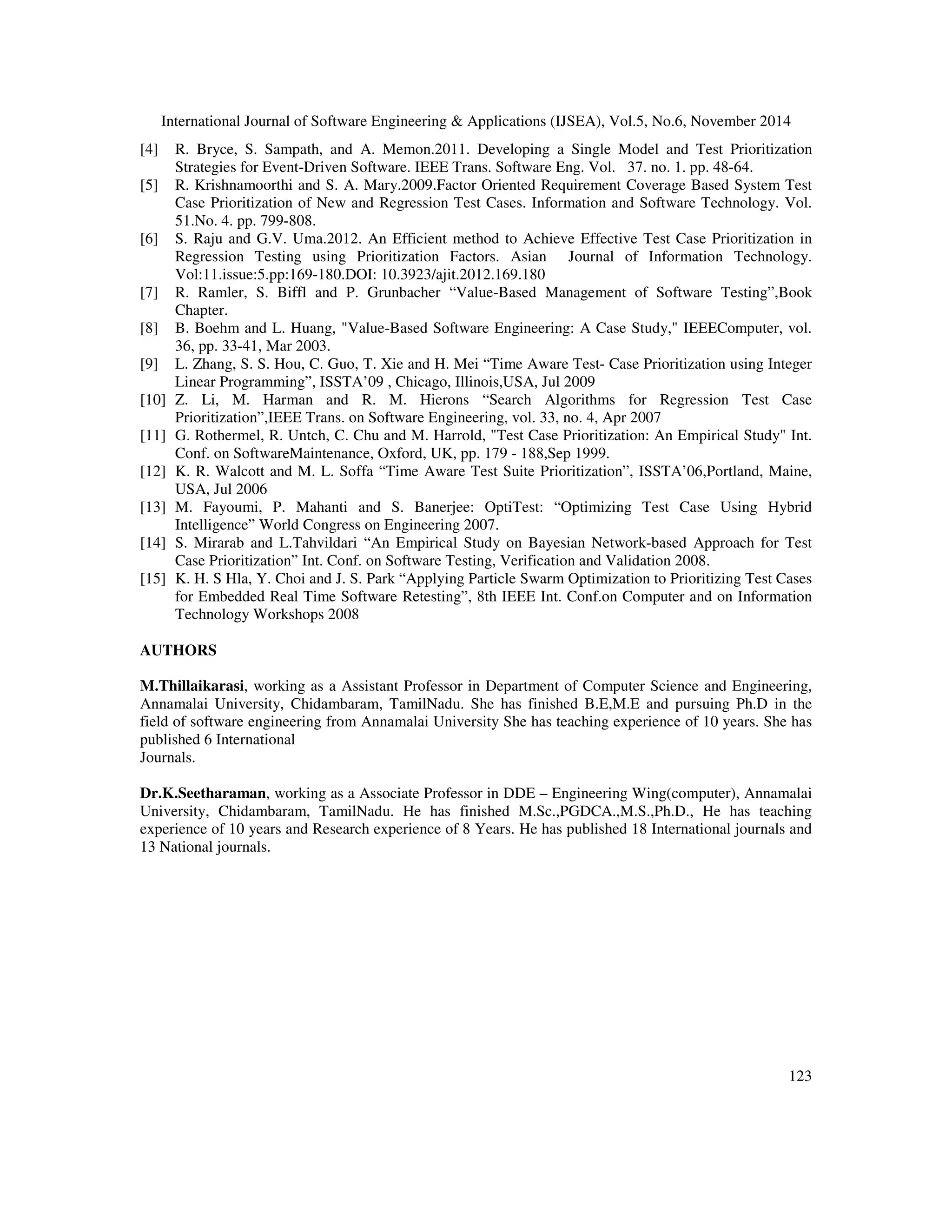The document discusses the effectiveness of test case prioritization techniques in regression testing, which is vital for detecting software regressions after code changes. It outlines a new prioritization approach applied in a banking application, highlighting its potential to enhance fault detection rates while reducing time and resource costs. The proposed prioritization algorithm relies on various weighted factors to improve the efficiency of regression test suites, demonstrating its applicability through empirical studies.

![International Journal of Software Engineering & Applications (IJSEA), Vol.5, No.6, November 2014
114
2. TECHNIQUES REVISITED
This segment narrates about the test case prioritization techniques to be used in our empirical
study are as follows:
Test case prioritization is an important regression testing technique, which approaches typically
and restructure existing test cases for regression testing accordingly to achieve targets.
Badhera et al.[1] presented a technique to execute the modified lines of code with minimum
number of test cases. The test case prioritization technique organizes the test case in a test suite
in an order such that fewer lines of code need to be executed. Thus faster code coverage is
attained which will lead to early detection of faults. Bixin Li et al.(2012) proposed an automatic
test case selection for regression testing of composite service, based on extensible BPEL flow
graph.
B. Jiang et al. [2] projected an ART-based prioritization method which uses the algorithm and
accepts the test suite as input, produces the output in prioritized order. The basic idea is about
building the candidate set of test cases, which in turn picks one test case from the candidate set
until all test cases have been selected. Here two functions are used in this algorithm for
calculating the distance between a pair of test cases and also to select a test case from the
candidate set. Calculation of distance is determined by code coverage data. Then we find a
candidate test case which is related with the distance test cases that has been prioritized earlier.
Dr. ArvinderKaur and ShubhraGoyal [3] developed a new genetic algorithm and prioritize
regression test suite within a time constrained environment on the basis of entire fault coverage.
This algorithm is automated and the results are analyzed with help of Average Percentage of
Faults Detected (APFD).
Hong Mei et al. [4] proposed a new approach for prioritizing test cases in the absence of coverage
information which is widely used in java programs under the JUnit framework. A new approach
called JUPTA which operates in the absence of coverage information and analyzes the static call
graphs of JUnit test cases. Further, it estimates the ability of each test case to achieve code
coverage and schedules the test cases in an order based on those estimates.
H.Do et al. [5] presented the importance of time constraints on test case prioritization and
discovered that constraints which alters the performance of technique. Further, conducted three
set of experiments which reveals the time constraints. The outcome show that the time constraint
factor play a significant role in determining the cost effectiveness and cost benefit trade-offs
among the techniques. Next experiment reproduces the first experiment, calculating several
threats to validate numbers of faults present. Third experiment manipulates the number of faults
present in programs to examine the effect of inaccuracy on prioritization and exhibits the relative
cost-effectiveness of prioritization techniques.
Park et al. [6] introduced a cost awareness model for the test case prioritization and fault
severities which revealed in the previous test execution. As well as it does not significantly
change form one outcome to another. Mohamed A Shameem et al. (2013) presented a metric for](https://image.slidesharecdn.com/effectivenessoftestcase-141208000112-conversion-gate01/75/Effectiveness-of-test-case-2-2048.jpg)
![International Journal of Software Engineering & Applications (IJSEA), Vol.5, No.6, November 2014
assessing the rate of fault detection. This algorithm identifies the faults in prior and the
effectiveness of prioritized test cases are compared with the non prioritized cases by Average
Percentage Of Fault Detection (APFD).
M. Yoon et al. [7] proposed a method to prioritize new test cases by estimating the requirements
of risk exposure value and also analyzing risk objects. Further it calculates the relevant test cases
and thereby determining the test case priority through the evaluated values. Moreover, we
demonstrate the effectiveness of our technique through empirical studies in terms of Average
Percentage Of Fault Detected (APFD) and fault severity.
R. Abreu et al. [8] projected a Spectrum-based multiple fault localization method to find out the
fault location apparently. R. Bryce et al. (2011) suggested a model which describes prioritization
criteria for GUI and web applications in an event driven software. The ultimate purpose is to
evolve the model and to develop a unified theory about testing of EDS.
R. Krishnamoorthi and S. A. Mary [9] presented a model that prioritizes the system test cases
based on six factors: customer priority, changes in requirement, implementation complexity,
usability, application flow and fault impact. This prioritization technique is examined in three
phases with student projects and two sets of industrial projects. Here results were found to
improve the rate of severe fault detection
S. Raju and G.V. Uma [10] initiated a cluster-based test case prioritization technique. Here, the
test cases are clustered based on their dynamic runtime behavior. Significantly researchers
reduced the required number of pair-wise comparisons. Researchers presented a value-driven
approach to system-level test case prioritization which prioritizes the requirements for test. Here,
prioritization of test cases is based on four factors: rate of fault detection, requirements volatility,
fault impact and implementation complexity.
The rest of this paper is organized as follows. Section three discusses about the proposed work.
Section four discusses about the experimental results and analysis. Section five discusses about
the test cases to be prioritized. Finally, section six consists of conclusion. References are given in
last section.
115
3. PROPOSED WORK
This section, briefly discusses about the prioritization factors.
3.1 Prioritization Weight Factors
It deals with, computation of prioritization factors such as (1) customer allotted priority , (2)
developer observed code execution complexity, (3) changes in requirements, (4) fault impact (5)
completeness and (6) traceability which is essential for prioritizing the test cases since they are
used in the prioritization algorithm. Weights are assigned to each test case in the software testing
according to the factors. Then, test cases are prioritized based on the weights assigned.](https://image.slidesharecdn.com/effectivenessoftestcase-141208000112-conversion-gate01/75/Effectiveness-of-test-case-3-2048.jpg)

